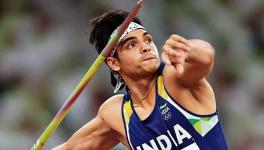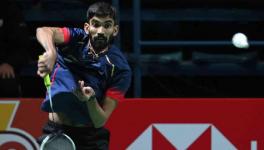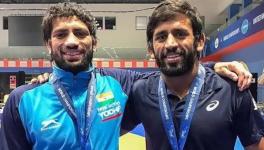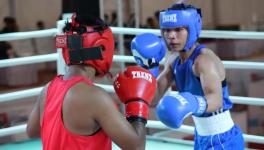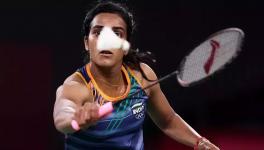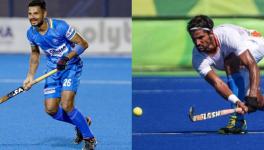Dutee Chand and Indian Sporting Truths at the Khelo India University Games

Dutee Chand racing againsts student athletes who are a second or more slower than her serves no purpose to anyone, except perhaps the larger marketing scheme of the Khelo India Games Organisers.
If there is one thing we know, cult of personality is the base ingredient for Indian sport. Celebrities aren’t spectators, they are brand ambassadors. Whether they know even the basic rules of the sport or not is secondary. The Khelo India Games (Youth and University) are no different. As heartwarming the thought is that this is helping grassroots sports in India, the truth is other things take precedence. The idea of spectacle precedes the idea of competition.
The sporting event’s central ingredient is always ONE person. It is a marketing hook. The ads themselves will tell you all you need to know. The sportsmen on the posters change — and first of all none of these ‘brand ambassadors’ are young people — but embossed in one corner is the looming figure of the megalomaniac in chief. Whether it be Assam or Odisha, he is there, watching you watch him watch you.
But this won’t do, because sport is essential to sporting events. Enter eminent local sportspeople. In Guwahati, at the Khelo India Youth Games, Hima Das was the central attraction. Her injury and subsequent confirmation of non-participation hugely impacted the local press and fans’ enthusiasm. A repeat would have been disastrous. So in Bhubaneswar, much before the Khelo India University Games were declared open, one thing was certain. Dutee Chand would run. She would run not just the 100m but also the 200m and she would do it at the end of the Games. Anticipation is good marketing.
Also Read | Virat Kohli and the Fine Art of Staying in a ‘Good Space’
When Dutee did run she did it comfortably enough to win, break the University records and also kick off her season — one where she will try her very best to make it to the Tokyo Olympics — perfectly. But in her post race scrums the races weren’t as much the talking point as you’d expect.
“The Khelo India University Games has been a good tournament for our state — Odisha. It was organised like an Asian Games, where the athletes were provided with accommodation, food and training facilities,” Dutee said, “The schedule of all events was strictly followed and the athletes were given ample rest as well. So, the competition was conducted very well and I would like to thank the Indian government and state government for organising the event.”
All of that is a bit like saying: Thanks for the soup, it was hot. Disregard the Asian Games comparison. The fact that an athlete considers a well organised event a privilege is a sign of how bad national federations are at doing even the basic things correctly.
There are other questions that have to be asked though. What was she doing there in the first place? This is not a smear on Dutee Chand at all, but she had no business being at the University Games this year. It’s a bit like Virat Kohli turning out for Sonnet cricket club for a hot weather tournament in Old Delhi in June. It’s well intentioned — her two races were perhaps better attended by the media than the entirety of the games themselves — but somewhat meaningless in the larger scheme of things.
In a backhanded compliment, Dutee admitted that while the games were great, they weren’t in themselves enough. “I think there should be two competitions per month in India,” she said. “The more competitions take place, the better we will do.”
But what kind of competitions? Dutee turning out twice a month against sprinters whose best times are almost a second slower than hers will do little to help her cause. The reverse also holds. Competing against competition far out of reach will dishearten athletes rather than inspire them.
Any athlete knows that improvement comes from quality competition. It isn’t about how often you race but who you race against. The correct method perhaps is to enter competitions where the cards aren’t stacked steeply for or against you. Dutee does that too.
There was a competition in India, right before the Khelo India Games that she chose not to attend. Almost all the athletes that turned up in Bhubaneswar had also participated in the Inter-University Games held in Moodbidri in January this year. Dutee didn’t. She didn’t because it wasn’t in Bhubaneswar, and wasn’t a marketing opportunity for the state or the government at the centre. She didn’t because it made no sense for her to go participate against student athletes in an event where she was going to dominate the competition. It was soup, with all the essential ingredients but no pizzazz.
Unfortunately, marketing takes over any well intentioned project, no matter the sphere it is operating in. Immediately after Dutee’s 100m on the first day came the 800 men’s final. Once the race finished, the competitors walked off without any drama or attention. Dutee was still in the mixed zone. Not a single camera turned their way. It took for the 800m women final for everyone to break out of their Dutee stupor and watch the action again. And even then, few watched the sport. The winner of that race was Harmilan Bains, a talented middle distance runner with the kind of genes that athletes pray for every day. She is the daughter of 1500m runner Amandeep Singh Bains and Madhuri Singh Bains — who won the Asian Games silver at the Busan Games in 2002.
Also Read | SAI Kokrajhar: Tales From an Indian Sports Outpost
But this wasn’t about sport. Bains is a photogenic athlete with a huge Instagram following. She is also a part-time model. Not one of the questions put to her in the scrum were about which event she preferred running, and how her smart strategy helped her land a superb middle distance double. Few cared about the fact that she had broken the 1500m University record the previous day, bettering an Asian medallist’s decade old mark.
No one asked her about the tough years she spent injured, on the sidelines, battling on with minimal financial support from the system. No one bothered to ask her who her parents were. All the male reporters in the scrum leered at her, asked her questions about her nails and her hair and what she would do to celebrate. The photographers clicked closeups of her in front of the branding billboards.
The next day a headline in the local paper made clear what the priorities were. “Meet the girl who brings glamour to athletics.” Another said: “not just a pretty face”. Because those are the things that matter.
Get the latest reports & analysis with people's perspective on Protests, movements & deep analytical videos, discussions of the current affairs in your Telegram app. Subscribe to NewsClick's Telegram channel & get Real-Time updates on stories, as they get published on our website.












